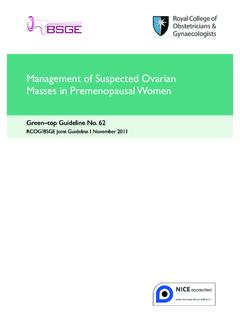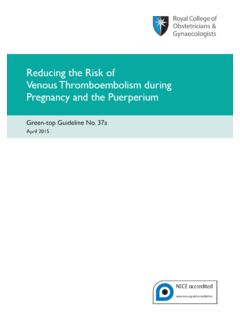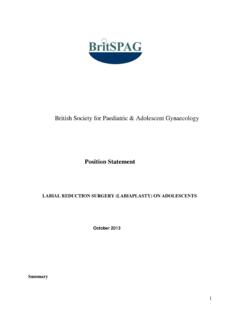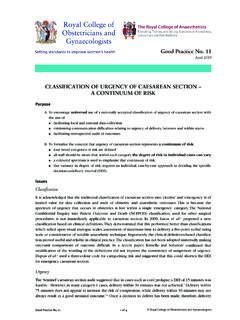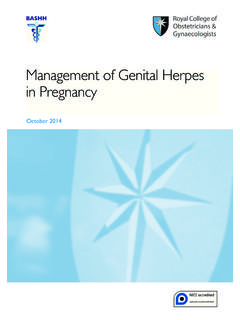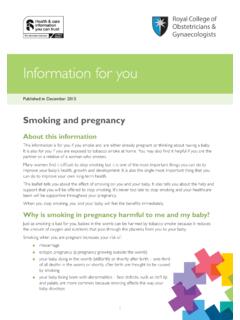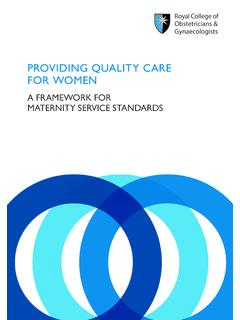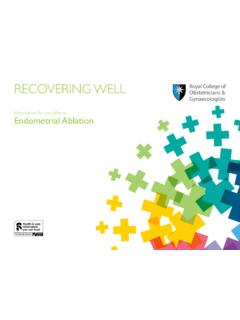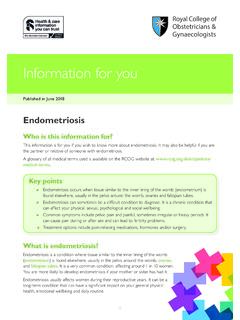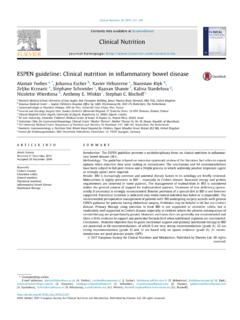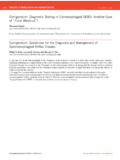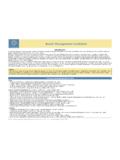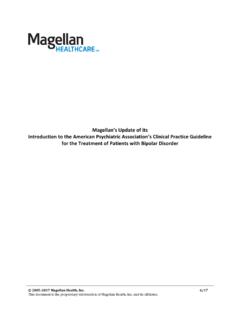Transcription of The Investigation and Treatment of Couples with …
1 The Investigation and Treatment of Couples with Recurrent First-trimester and second -trimesterMiscarriageGreen-top Guideline No. 17 April 2011 The Investigation and Treatment of Couples with RecurrentFirst-trimester and second -trimester MiscarriageThis is the third edition of this guideline,which was first published in 1998 and then in 2003 under thetitle The Investigation and Treatment of Couples with Recurrent and scopeThe purpose of this guideline is to provide guidance on the Investigation and Treatment of Couples withthree or more first-trimester miscarriages, or one or more second -trimester and introductionMiscarriage is defined as the spontaneous loss of pregnancy before the fetus reaches viability. The termtherefore includes all pregnancy losses from the time of conception until 24 weeks of gestation. It shouldbe noted that advances in neonatal care have resulted in a small number of babies surviving birth before24 weeks of miscarriage , defined as the loss of three or more consecutive pregnancies, affects 1% of couplestrying to has been estimated that 1 2% of second -trimester pregnancies miscarry before 24weeks of and assessment of evidenceThe Cochrane Library and Cochrane Register of Controlled Trials were searched for relevant randomisedcontrolled trials, systematic reviews and meta-analyses.
2 A search of Medline from 1966 to 2010 was alsocarried out. The date of the last search was November 2010. In addition, relevant conference proceedingsand abstracts were databases were searched using the relevant MeSH terms including all sub-headings. This was combinedwith a keyword search using human , female , pregnancy , abortion , miscarriage , habitual , recurrent , randomised controlled trials and meta-analysis .The definitions of the types of evidence used in this guideline originate from the Scottish IntercollegiateGuidelines Network (SIGN) grading scheme. Where possible, recommendations are based on, and explicitlylinked to, the evidence that supports them. Areas lacking evidence are highlighted and annotated as goodpractice points. 4. Risk factors for recurrent miscarriageWhat are the causes of recurrent first trimester miscarriage and second trimester miscarriage ? Epidemiological factorsMaternal age and number of previous miscarriages are two independent risk factors for a ,4 Advancing maternal age is associated with a decline in both the number and quality of theremaining oocytes.
3 A large prospective register linkage study3reported the age-related risk of miscarriagein recognised pregnancies to be: 12 19 years, 13%; 20 24 years, 11%; 25 29 years, 12%; 30 34 years, 15%;35 39 years, 25%; 40 44 years, 51%; and 45 years, 93%. Advanced paternal age has also been identified asa risk factor for miscarriage . The risk of miscarriage is highest among Couples where the woman is 35years of age and the man 40 years of Royal College of Obstetricians and Gynaecologists2of 18 RCOG Green-top Guideline No. 17 RCOG Green-top Guideline No. 173of 18 Royal College of Obstetricians and GynaecologistsPrevious reproductive history is an independent predictor of future pregnancy outcome. The risk of afurther miscarriage increases after each successive pregnancy loss,reaching approximately 40% after threeconsecutive pregnancy losses,and the prognosis worsens with increasing maternal ,4A previous livebirth does not preclude a woman developing recurrent evidence on the effect of environmental risk factors is based mainly on data studying women withsporadic rather than recurrent miscarriage .
4 The results are conflicting and biased by difficulties incontrolling for confounding factors and the inaccuracy of data on exposure and the measurement of toxindose. Maternal cigarette smoking and caffeine consumption have been associated with an increased riskof spontaneous miscarriage in a dose-dependent manner. However, current evidence is insufficient toconfirm this 9 Heavy alcohol consumption is toxic to the embryo and the fetus. Even moderateconsumption of five or more units per week may increase the risk of sporadic withor using video display terminals does not increase the risk of evidence on the effect ofanaesthetic gases for theatre workers is ,13 Recent retrospective studies have reported that obesity increases the risk of both sporadic and Antiphospholipid syndromeAntiphospholipid syndrome is the most important treatable cause of recurrent miscarriage . Antiphos-pholipid syndrome refers to the association between antiphospholipid antibodies lupus anticoagulant,anticardiolipin antibodies and anti-B2glycoprotein-I antibodies and adverse pregnancy outcome orvascular ,18 Adverse pregnancy outcomes include: three or more consecutive miscarriages before 10 weeks of gestation one or more morphologically normal fetal losses after the 10th week of gestation one or more preterm births before the 34th week of gestation owing to placental disease.
5 The mechanisms by which antiphospholipid antibodies cause pregnancy morbidity include inhibition oftrophoblastic function and differentiation,19 23activation of complement pathways at the maternal fetalinterface resulting in a local inflammatory response24and, in later pregnancy, thrombosis of the uteropla-cental 27In vitro studies have shown that the effect of antiphospholipid antibodies ontrophoblast function28,29and complement activation30is reversed by heparin. Antiphospholipid antibodies are present in 15% of women with recurrent comparison,the prevalence of antiphospholipid antibodies in women with a low-risk obstetric history is less than2%.32,33In women with recurrent miscarriage associated with antiphospholipid antibodies, the live birthrate in pregnancies with no pharmacological intervention has been reported to be as low as 10%. Parental chromosomal rearrangementsIn approximately 2 5% of Couples with recurrent miscarriage , one of the partners carries a balancedstructural chromosomal anomaly:most commonly a balanced reciprocal or Robertsonian 38 Although carriers of a balanced translocation are usually phenotypically normal, their pregnancies are atincreased risk of miscarriage and may result in a live birth with multiple congenital malformation and/ormental disability secondary to an unbalanced chromosomal arrangement.
6 The risk of miscarriage isinfluenced by the size and the genetic content of the rearranged chromosomal segments. Embryonic chromosomal abnormalitiesIn Couples with recurrent miscarriage , chromosomal abnormalities of the embryo account for 30 57% offurther ,40 The risk of miscarriage resulting from chromosomal abnormalities of the embryoincreases with advancing maternal age. However, it is important to note that as the number of miscar-riages increases, the risk of euploid pregnancy loss , Congenital uterine malformationsThe exact contribution that congenital uterine anomalies make to recurrent miscarriage remains unclearsince the prevalence and reproductive implications of uterine anomalies in the general population areunknown. The reported prevalence of uterine anomalies in recurrent miscarriage populations rangesbetween and ,43 This variability reflects the differences in the criteria and techniques usedfor diagnosis and the fact that available studies have included women with two, three or more miscar-riages in both the first and second trimester of pregnancy.
7 The prevalence of uterine malformations appearsto be higher in women with second -trimester miscarriages compared with women who suffer first-trimester miscarriages,but this may be related to the cervical weakness that is frequently associated withuterine has been reported that women with arcuate uteri tend to miscarry more in thesecond trimester while women with septate uteri are more likely to miscarry in the first retrospective review of reproductive performance in women with untreated uterine anomalies hassuggested that these women experience high rates of miscarriage and preterm delivery, with a termdelivery rate of only 50%.42 However, retrospective studies are biased by patient selection and,until wellcontrolled prospective data become available, the role of uterine anomalies in recurrent miscarriage willremain debatable. Cervical weaknessCervical weakness is a recognised cause of second -trimester miscarriage , but the true incidence isunknown, since the diagnosis is essentially a clinical one.
8 There is currently no satisfactory objective testthat can identify women with cervical weakness in the non-pregnant state. The diagnosis is usually basedon a history of second -trimester miscarriage preceded by spontaneous rupture of membranes or painlesscervical dilatation. factorsSystemic maternal endocrine disorders such as diabetes mellitus and thyroid disease have been associatedwith miscarriage . Women with diabetes who have high haemoglobin A1c levels in the first trimester areat risk of miscarriage and fetal , well-controlled diabetes mellitus is not a riskfactor for recurrent miscarriage , nor is treated thyroid ,48 The prevalence of diabetes mellitusand thyroid dysfunction in women who suffer recurrent miscarriage is similar to that reported in thegeneral ,50 Anti-thyroid antibodies have been linked to recurrent miscarriage . However, one case controlstudy51from 1998 has reported that women with recurrent miscarriages are no more likelythan women without recurrent miscarriage to have circulating thyroid antibodies.
9 A singleprospective study52has shown that the presence of thyroid antibodies in euthyroid womenwith a history of recurrent miscarriage does not affect future pregnancy ovary syndrome (PCOS) has been linked to an increased risk of miscarriage but the exactmechanism remains unclear. Polycystic ovarian morphology, elevated serum luteinising hormone levels orelevated serum testosterone levels, although markers of PCOS, do not predict an increased risk of futureRCOG Green-top Guideline No. 174of 18 Royal College of Obstetricians and GynaecologistsEvidencelevel 3pregnancy loss among ovulatory women with a history of recurrent miscarriage who conceive increased risk of miscarriage in women with PCOS has been recently attributed to insulinresistance, hyperinsulinaemia and hyperandrogenaemia. The prevalence of insulin resistance is increased inwomen with recurrent miscarriage compared with matched fertile elevated free androgenindex appears to be a prognostic factor for a subsequent miscarriage in women with recurrent Immune factorsThere is no clear evidence to support the hypothesis of human leucocyte antigen incompatibility betweencouples, the absence of maternal leucocytotoxic antibodies or the absence of maternal blocking ,they should not be offered routinely in the Investigation of Couples with recurrent miscarriage .
10 Natural killer (NK) cells are found in peripheral blood and the uterine mucosa. Peripheral blood NK cellsare phenotypically and functionally different from uterine NK (uNK) is no clear evidence thataltered peripheral blood NK cells are related to recurrent ,58 Therefore, testing for peripheralblood NK cells as a surrogate marker of the events at the maternal fetal interface is inappropriate andshould not be offered routinely in the Investigation of Couples with recurrent has been suggested that uNK cells may play a role in trophoblastic invasion and angiogenesis in additionto being an important component of the local maternal immune response to should benoted that the largest study60examining the relationship between uNK cell numbers and future pregnancyoutcome reported that raised uNK cell numbers in women with recurrent miscarriage was not associatedwith an increased risk of miscarriage . This remains a research field and testing for uNK cells should not beoffered routinely in the Investigation of recurrent are immune molecules that control both immune and other cells.
